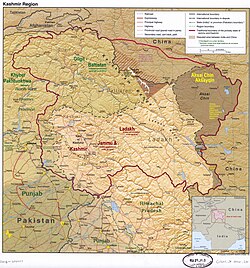Muzaffarabad District
Pakistani administrative area From Wikipedia, the free encyclopedia
The Muzaffarabad District (Urdu: ضلع مُظفّرآباد) is a district of Pakistan-administered Azad Kashmir in the disputed Kashmir region.[1] It is one of the 10 districts of this dependent territory. The district is located on the banks of the Jhelum and Neelum rivers and is very hilly. The total area of the Muzaffarabad District is 1,642 square kilometres (634 sq mi). The district is part of the Muzaffarabad Division, and the city of Muzaffarabad serves as the capital of Azad Kashmir. The district is bounded on the north-east by the Neelum District and the Kupwara district of Indian-administered Jammu and Kashmir region, on the south-east by the Hattian Bala District, on the south by the Bagh District, and on the west by the Mansehra and Abbottabad districts of Pakistan's Khyber Pakhtunkhwa Province.

Muzaffarabad District
ضلع مُظفّرآباد | |
|---|---|
District of Azad Kashmir administered by Pakistan[1] | |
 The city of Muzaffarabad, Azad Kashmir | |
 Interactive map of Muzaffarabad district | |
 A map showing Pakistani-administered Gilgit-Baltistan (shaded in sage green) in the disputed Kashmir region[1] | |
| Coordinates (Muzaffarabad): 34°20′N 73°36′E | |
| Administering country | Pakistan |
| Territory | Azad Kashmir |
| Division | Muzaffarabad Division |
| Headquarters | Muzaffarabad |
| Government | |
| • Type | District Administration |
| • Deputy Commissioner | Raja Tahir Mumtaz |
| • District Police Officer | N/A |
| • District Education Officer Male/Female | Tariq Shafi/Saima Nazir |
| • District Nazim | Imtiaz Ahmad Abbasi |
| Area | |
• Total | 1,642 km2 (634 sq mi) |
| Population (2017) | |
• Total | 650,370 |
| • Density | 396/km2 (1,030/sq mi) |
| Languages | |
| • Official | Urdu |
| • Spoken | |
| Number of Tehsils | 2 |
Population and languages
Summarize
Perspective
The total population of the district, according to the 2017 census, is 650,370.[2]
The main language of the district, spoken by about half of its inhabitants,[3] is generally considered to be a variety of Pahari. Though occasionally referred to in the literature as Chibhali [4] or Poonchi,[5] it is locally known as Hindko.[6] Its speakers tend to identify more with the Hindko spoken to the west,[7] even though perceiving their speech to be only slightly different from the Pahari varieties spoken in the Bagh District and further south in Murree.[8] The local dialect has a higher percentage of shared basic vocabulary with the central group of Pahari dialects (83–88%) than with the Hindko of the nearby Mansehra and Abbottabad districts (73–79%).[9]
Another language spoken in the district is Gujari, native to around a third of its population.[3] The local dialect is closely related to the Gujari varieties spoken in Hazara (83–88% similarity in basic vocabulary) and the rest of Azad Kashmir (79–86%).[10] Kashmiri is spoken in the city of Muzaffarabad. It is distinct from, although still intelligible with, the Kashmiri of the Neelam Valley to the north.[11] Other languages spoken include Urdu, Shina and Balti.[citation needed]
Administrative divisions
The district of Muzaffarabad is administratively subdivided into two tehsils, which are subdivided into several union councils.[12]
Education
Muzaffarabad's education system exhibits a disparity between its overall ranking and school infrastructure. While the district achieved a national ranking of 6th with a score of 73.85 in the 2017 Pakistan District Education Ranking (by Alif Ailaan), its school infrastructure score was significantly lower at 105th with a score of 34.29.[13] This disparity highlights a lack of basic amenities in many schools, including electricity (11.7 score), drinking water (27.93 score), and boundary walls (40.09 score).[13] These shortcomings create an environment not conducive to learning.
Furthermore, the district faces a shortage of higher-level educational institutions. With 72% of schools being primary and only 28% offering above-primary education, students graduating from primary schools have limited options for continuing their education. This limited access, particularly for girls, contributes to a decline in enrollment rates. Reports on the Taleem Do app for the area substantiate these concerns, highlighting issues with inadequate infrastructure and a lack of furniture in schools.
Notes
References
Bibliography
External links
Wikiwand - on
Seamless Wikipedia browsing. On steroids.
